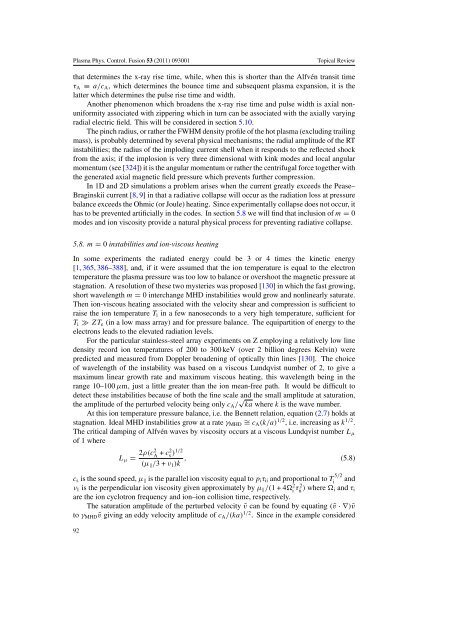You also want an ePaper? Increase the reach of your titles
YUMPU automatically turns print PDFs into web optimized ePapers that Google loves.
Plasma Phys. Control. Fusion 53 (2011) 093001<br />
Topical Review<br />
that determines <strong>the</strong> x-ray rise time, while, when this is shorter than <strong>the</strong> Alfvén transit time<br />
τ A ≡ a/c A , which determines <strong>the</strong> bounce time and subsequent plasma expansion, it is <strong>the</strong><br />
latter which determines <strong>the</strong> pulse rise time and width.<br />
Ano<strong>the</strong>r phenomenon which broadens <strong>the</strong> x-ray rise time and pulse width is axial nonuniformity<br />
associated with zippering which in turn can be associated with <strong>the</strong> axially varying<br />
radial electric field. This will be considered in section 5.10.<br />
The <strong>pinch</strong> radius, or ra<strong>the</strong>r <strong>the</strong> FWHM density pr<strong>of</strong>ile <strong>of</strong> <strong>the</strong> hot plasma (excluding trailing<br />
mass), is probably determined by several physical mechanisms; <strong>the</strong> radial amplitude <strong>of</strong> <strong>the</strong> RT<br />
instabilities; <strong>the</strong> radius <strong>of</strong> <strong>the</strong> imploding current shell when it responds to <strong>the</strong> reflected shock<br />
from <strong>the</strong> axis; if <strong>the</strong> implosion is very three dimensional with kink modes and local angular<br />
momentum (see [324]) it is <strong>the</strong> angular momentum or ra<strong>the</strong>r <strong>the</strong> centrifugal force toge<strong>the</strong>r with<br />
<strong>the</strong> generated axial magnetic field pressure which prevents fur<strong>the</strong>r compression.<br />
In 1D and 2D simulations a problem arises when <strong>the</strong> current greatly exceeds <strong>the</strong> Pease–<br />
Braginskii current [8, 9] in that a radiative collapse will occur as <strong>the</strong> radiation loss at pressure<br />
balance exceeds <strong>the</strong> Ohmic (or Joule) heating. Since experimentally collapse does not occur, it<br />
has to be prevented artificially in <strong>the</strong> codes. In section 5.8 we will find that inclusion <strong>of</strong> m = 0<br />
modes and ion viscosity provide a natural physical process for preventing radiative collapse.<br />
5.8. m = 0 instabilities and ion-viscous heating<br />
In some experiments <strong>the</strong> radiated energy could be 3 or 4 times <strong>the</strong> kinetic energy<br />
[1, 365, 386–388], and, if it were assumed that <strong>the</strong> ion temperature is equal to <strong>the</strong> electron<br />
temperature <strong>the</strong> plasma pressure was too low to balance or overshoot <strong>the</strong> magnetic pressure at<br />
stagnation. A resolution <strong>of</strong> <strong>the</strong>se two mysteries was proposed [130] in which <strong>the</strong> fast growing,<br />
short wavelength m = 0 interchange MHD instabilities would grow and nonlinearly saturate.<br />
Then ion-viscous heating associated with <strong>the</strong> velocity shear and compression is sufficient to<br />
raise <strong>the</strong> ion temperature T i in a few nanoseconds to a very high temperature, sufficient for<br />
T i ≫ ZT e (in a low mass array) and for pressure balance. The equipartition <strong>of</strong> energy to <strong>the</strong><br />
electrons leads to <strong>the</strong> elevated radiation levels.<br />
For <strong>the</strong> particular stainless-steel array experiments on Z employing a relatively low line<br />
density record ion temperatures <strong>of</strong> 200 to 300 keV (over 2 billion degrees Kelvin) were<br />
predicted and measured from Doppler broadening <strong>of</strong> optically thin lines [130]. The choice<br />
<strong>of</strong> wavelength <strong>of</strong> <strong>the</strong> instability was based on a viscous Lundqvist number <strong>of</strong> 2, to give a<br />
maximum linear growth rate and maximum viscous heating, this wavelength being in <strong>the</strong><br />
range 10–100 µm, just a little greater than <strong>the</strong> ion mean-free path. It would be difficult to<br />
detect <strong>the</strong>se instabilities because <strong>of</strong> both <strong>the</strong> fine scale and <strong>the</strong> small amplitude at saturation,<br />
<strong>the</strong> amplitude <strong>of</strong> <strong>the</strong> perturbed velocity being only c A / √ ka where k is <strong>the</strong> wave number.<br />
At this ion temperature pressure balance, i.e. <strong>the</strong> Bennett relation, equation (2.7) holds at<br />
stagnation. Ideal MHD instabilities grow at a rate γ MHD<br />
∼ = cA (k/a) 1/2 , i.e. increasing as k 1/2 .<br />
The critical damping <strong>of</strong> Alfvén waves by viscosity occurs at a viscous Lundqvist number L µ<br />
<strong>of</strong> 1 where<br />
L µ = 2ρ(c2 A + c2 s )1/2<br />
(µ ‖ /3+ν 1 )k , (5.8)<br />
c s is <strong>the</strong> sound speed, µ ‖ is <strong>the</strong> parallel ion viscosity equal to p i τ ii and proportional to T 5/2<br />
i<br />
and<br />
ν 1 is <strong>the</strong> perpendicular ion viscosity given approximately by µ ‖ /(1+4 2 i τ ii 2)<br />
where i and τ i<br />
are <strong>the</strong> ion cyclotron frequency and ion–ion collision time, respectively.<br />
The saturation amplitude <strong>of</strong> <strong>the</strong> perturbed velocity ṽ can be found by equating (ṽ ·∇)ṽ<br />
to γ MHD ṽ giving an eddy velocity amplitude <strong>of</strong> c A /(ka) 1/2 . Since in <strong>the</strong> example considered<br />
92














